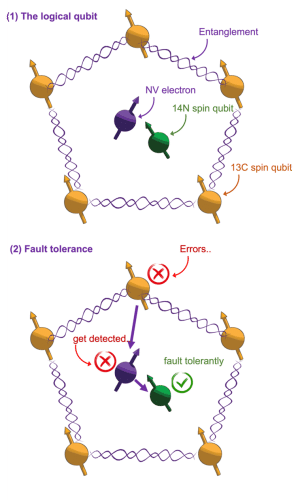According to Fujitsu, Element Six, and QuTech researchers who designed and manufactured one, spin qubits in diamond can be made fault-tolerant.
Quantum bits are noisy, and ways to deal with this noise in quantum computers are required if they are to be functional. Instead of working with single qubits, one option is to perform identical operations on groups of linked physical qubits, combining their noisy outputs to generate a single logical qubit that is less noisy.
“Such fault tolerance enables reliable computation with noisy components and is the key to realising quantum computers,” according to QuTech, a Netherlands-based quantum component research company spun out from university TU Delft and national research lab TNO.
The qubits in question are made up of five entangled (purple) spin qubits that are created by 13C nuclear spins in diamond at 10K (see diagram below). Electron spin in a nitrogen-vacancy centre (also purple) is employed as an extra helper qubit to detect faults, while a second helper qubit (green, created using 14N nuclear spin) recognises such errors.

The processor has a custom encoding system that QuTech claims can deliver the correct result despite any single error anywhere in the system – the company claims that the University of Southern California has determined that a seven qubit system is the smallest configuration that allows fault-tolerant error-correction. QuTech’s 29-qubit quantum processor, in which the qubits are embedded in ultra-pure diamond produced by Element Six, can maintain coherent quantum states “for minutes,” according to QuTech.
“Because of the long coherence times of our qubits,” said project supervisor Tim Taminiau, “we could process the outcomes of the measurements on-the-fly while the processor was running. Very few systems around the world currently have this capability.” That said, “there is still a long way to go for large-scale fault-tolerant computation,” said fellow supervisor Barbara Terhal. “Truly suppressing errors will require further improvements in the number of qubits and the quality of operations.”
Beyond the demonstration, the researchers want to pursue a modular approach, using optical quantum interconnects to connect numerous computers identical to the proof-of-concept into a bigger one, all run by conventional control circuits.
“Making many copies of small processors and connecting them together into one large quantum computer, is a flexible way to address the challenge of scaling up the number of qubits,” said Taminiau, who added that QuTech already has the interconnect technology and is working on other necessary parts.







